Barrenwort Epimedium 'Black Sea'

ABOUT
The Epimedium 'Black Sea', commonly referred to as the Barrenwort, is a visually striking plant known for its distinctive foliage and flowers. The leaves of this plant are often heart-shaped, with a leathery texture that can showcase a variety of colors throughout the seasons. During the spring, the new growth may exhibit a reddish-bronze hue, which transitions to a lush green as the season progresses. In the fall, the foliage may change again, displaying shades of deep bronze to black, hence the epithet 'Black Sea.' Barrenwort produces delicate, nodding flowers that add a whimsical touch to its appearance. The blossoms typically appear in clusters on wiry, slender stems that arch away from the body of the plant. These flowers are composed of four outer sepals that resemble petals; they can be in shades that range from pale yellows to deep purples, often with a contrasting center, giving the impression of a small, intricate lantern hanging amidst the foliage. The plant exudes a cottage-garden charm and is often appreciated for the layer of texture and color it contributes to garden compositions. Its foliage and flowers juxtapose beautifully with other shade-loving plants in a garden setting, making Epimedium 'Black Sea' a favored choice among garden enthusiasts for its ornamental qualities and its adaptability to a variety of garden themes and styles.
About this plant
 Names
NamesFamily
Berberidaceae.
Synonyms
Horned Goat Weed, Rowdy Lamb Herb, Bishop's Hat, Barrenwort, Fairy Wings.
Common names
Epimedium 'Black Sea'
 Toxicity
ToxicityTo humans
The plant commonly known as horny goat weed, which includes the variety 'Black Sea', is not generally considered to be toxic to humans. There is limited information on the toxicity of Epimedium species when ingested by humans, but they are typically grown as ornamental plants and have even been used in traditional medicine. However, as with any plant, individual allergic reactions or sensitivities can occur, and consuming any plant material that is not typically recognized as edible should be done with caution to avoid potential gastrointestinal discomfort or other adverse effects.
To pets
The horny goat weed, including the 'Black Sea' variety, does not have a well-documented history of being toxic to pets. While Epimedium species are not generally known to contain compounds that are highly toxic to dogs or cats, ingestion of non-food plants by pets can sometimes lead to mild gastrointestinal upset, such as vomiting or diarrhea. If a pet ingests a substantial amount of the plant and shows symptoms of distress, it is advisable to contact a veterinarian.
 Characteristics
CharacteristicsLife cycle
Perennials
Foliage type
Semi-deciduous
Color of leaves
Varies
Flower color
Yellow
Height
1 feet 4 inches (40 cm)
Spread
1 feet 8 inches (50 cm)
Plant type
Herb
Hardiness zones
5
Native area
Mediterranean
Benefits
 General Benefits
General Benefits- Low maintenance: Epimedium 'Black Sea' is easy to care for and does not require regular attention once established.
- Drought tolerant: Once established, it can withstand periods of drought, making it suitable for drier climates or water-conserving gardens.
- Shade tolerant: It thrives in partial to full shade, making it useful for underplanting or brightening up shady areas of the garden.
- Tolerates a variety of soils: It can grow in a range of soil types, from well-drained to clay soils.
- Ground cover: The plant forms a dense mat that can help suppress weeds and cover bare spots in the garden.
- Deer and rabbit resistant: Its foliage is unappealing to deer and rabbits, making it a good choice for areas where these animals are a nuisance.
- Attractive foliage: The leaves of Epimedium 'Black Sea' provide visual interest with their dark color and may change throughout the seasons.
- Spring flowers: It produces delicate flowers in the spring that add a splash of color to the garden.
- Winter interest: Some Epimedium varieties retain their leaves in mild winters, providing greenery and texture year-round.
 Medical Properties
Medical Properties- This plant is not used for medical purposes.
 Air-purifying Qualities
Air-purifying QualitiesThis plant is not specifically known for air purifying qualities.
 Other Uses
Other Uses- Barrier Planting: Epimedium 'Black Sea', commonly known as Horny Goat Weed, can be used to create a dense ground cover that deters weeds and encroachment from other aggressive plants.
- Erosion Control: Due to its robust rooting system, this plant is effective at holding soil in place on slopes and in areas prone to erosion.
- Leaf Litter for Compost: Its leaves can be added to compost piles to enrich the compost with essential nutrients as they break down.
- Garden Border Edging: Can be planted along the edges of garden paths or flower beds to provide neat, low borders that define different areas in a garden.
- Livestock Fodder: In some regions, the plant may be used as fodder for certain types of livestock, particularly goats.
- Butterfly Attraction: The flowers of Horny Goat Weed can attract butterflies and beneficial insects, adding to the biodiversity of the garden ecosystem.
- Winter Garden Interest: With its evergreen leaves, it provides visual interest in the garden even during the dormant winter months.
- Thematic Garden Component: This plant's unique foliage and flowers can be a part of thematic gardens, such as an Asian-inspired garden or a foliage-focused display.
- Photography Subject: Garden photographers may use the striking foliage and flowers of Epimedium 'Black Sea' as subjects for botanical photography.
- Artistic Inspiration: The intricate leaves and flowers can be used as inspiration for botanical drawings, paintings, and other artistic endeavors.
Interesting Facts
 Feng Shui
Feng ShuiThe plant Horned Goat Weed is not used in Feng Shui practice.
 Zodiac Sign Compitability
Zodiac Sign CompitabilityThe plant Horned Goat Weed is not used in astrology practice.
 Plant Symbolism
Plant Symbolism- Passionate Love: Epimedium, commonly known as "Horny Goat Weed," is often associated with passionate love, as it is believed in folklore to have aphrodisiac properties that kindle romantic desire.
- Libido and Fertility: Due to its use in traditional medicine to enhance sexual function, it symbolizes fertility and the strength of libido.
- Youthful Energy: Epimedium is often related to vitality and the rejuvenation of energy, hinting at the restoration of a youthful state.
- Longevity: In some cultures, Epimedium is taken as a tonic for overall well-being and is thought to contribute to a long, healthy life.
 Water
WaterFor Epimedium 'Black Sea', also known as barrenwort, ensure the soil remains consistently moist, especially during its growing season in spring and summer. In general, water approximately once a week with about 1 inch of water, but adjust frequency depending on the weather and soil moisture levels. Barrenworts do not tolerate drought well, so increase watering during particularly hot or dry periods. In the cooler months of fall and winter, reduce watering to every couple of weeks or when the soil feels dry to the touch, since the plant's water requirements diminish as growth slows.
 Light
LightBarrenwort thrives in partial to full shade, making it an excellent choice for woodland gardens or shaded areas beneath trees. If you're planting Epimedium 'Black Sea', position it where it will receive dappled sunlight or light shade throughout the day, as intense direct sunlight can scorch the foliage, especially in hotter climates.
 Temperature
TemperatureBarrenwort is adaptable to a range of temperatures and can typically withstand winter cold down to about 0 degrees Fahrenheit. However, its ideal growing conditions feature temperate climates, where temperatures range between 50 and 70 degrees Fahrenheit. It's important to provide protection like mulch during extreme cold spells to ensure the root system remains insulated.
 Pruning
PruningBarrenwort benefits from pruning to remove old, damaged, or discolored foliage and to promote healthy growth. Pruning is best done in late winter or early spring before new growth starts. Cut back any spent foliage from the previous season; this also helps prevent diseases and pests. Pruning annually ensures a tidier appearance and rejuvenates the plant for vigorous spring growth.
 Cleaning
CleaningAs needed
 Soil
SoilThe best soil mix for Bishop's Hat (Epimedium 'Black Sea') should be rich in organic matter, well-draining, and slightly acidic to neutral, with a pH of 5.5 to 7.0. A mix consisting of garden loam, compost, and coarse sand or pine bark in equal parts can provide an ideal growing medium for this plant.
 Repotting
RepottingBishop's Hat does not require frequent repotting and can typically be repotted every 2 to 3 years or when it becomes root-bound. Spring is the best time to repot this perennial plant to minimize stress and encourage healthy growth during its active season.
 Humidity & Misting
Humidity & MistingBishop's Hat thrives in average humidity conditions, ideally between 30% to 50%. Excessive humidity is not required, making it well-suited for growth in most indoor environments without the need for extra humidity.
 Suitable locations
Suitable locationsIndoor
Place Bishop’s Hat in bright, indirect light with moderate watering.
Outdoor
Grow Bishop's Hat in partial shade, enriched soil, protect from hot sun.
Hardiness zone
5-9 USDA
 Life cycle
Life cycleEpimedium 'Black Sea', also known as Barrenwort, begins its life cycle when seeds are sown in well-draining soil and germinate, typically requiring a period of cold stratification to break dormancy. Upon germination, seedlings develop a root system and produce juvenile foliage, growing into young plants. During the spring, Barrenwort enters a rapid growth phase, where mature leaves and distinctive flowers emerge, with the plant thriving in partial to full shade. Once flowering ends, typically in late spring to early summer, the plant focuses on vegetative growth, establishing a denser clump through rhizomatous spread. Throughout the growing season, the foliage may change color, with some varieties taking on a darker hue in response to cooler temperatures. Finally, as winter approaches, Barrenwort becomes dormant, with above-ground parts dying back, and stores energy in the rhizomes for the next growing season.
 Propogation
PropogationPropogation time
Spring to Summer
Propogation: The most popular method of propagating the Epimedium 'Black Sea', also known as the Barrenwort, is by division. This process typically occurs in late winter or early spring before new growth begins. To propagate by division, carefully dig up an established clump and gently separate the rhizomes, ensuring that each division has at least one growing point. The divisions should then be immediately replanted in prepared soil with good drainage, spacing them about 12 inches (approximately 30 centimeters) apart to allow for growth. Water the new plantings thoroughly to establish them. This method ensures that the new plants will be true to the parent and allows for quick establishment in the garden.

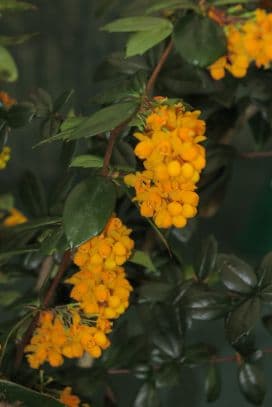
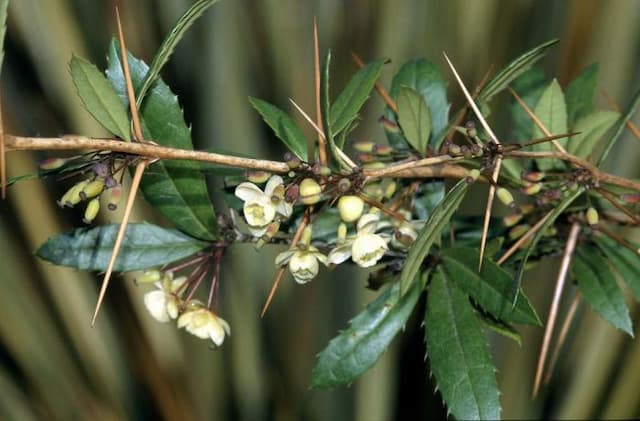
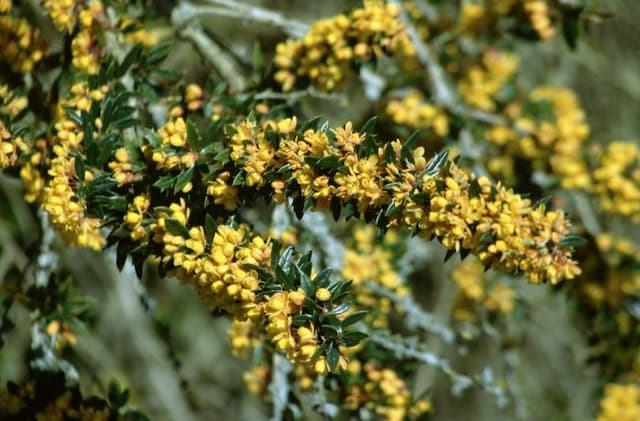

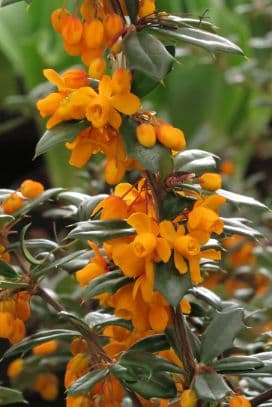
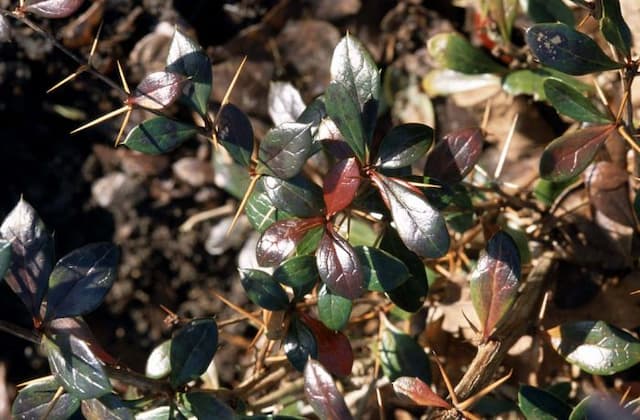


![Japanese barberry [Bonanza Gold]](/_next/image?url=https%3A%2F%2Fplants-admin.emdemapps.com%2Fimages%2Fplants%2F%2Fimages%2F604b5385e413f.png&w=640&q=75)